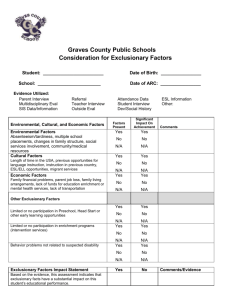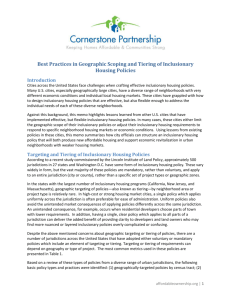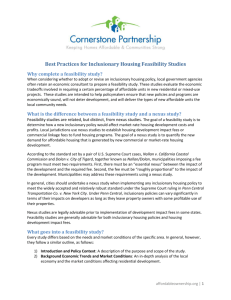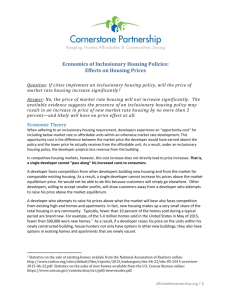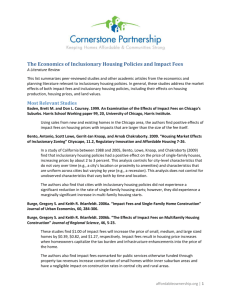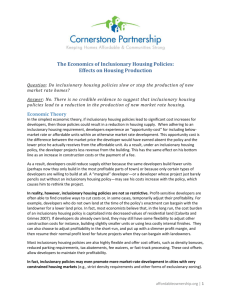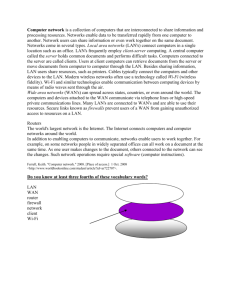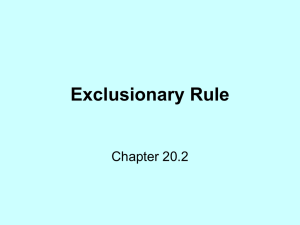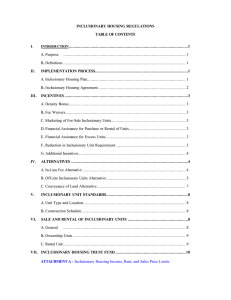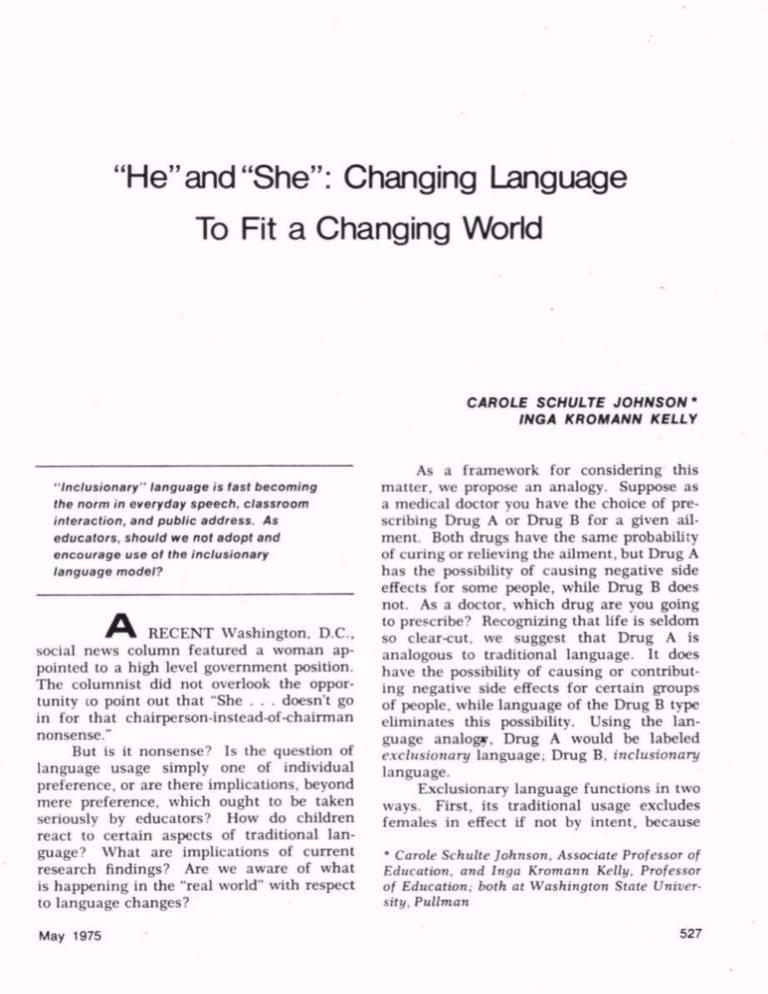
"He"and "She": Changing Language
To Fit a Changing World
CAROLE SCHULTE JOHNSON"
INGA KROMANN KELLY
"Inclusionary" language is fast becoming
the norm in everyday speech, classroom
interaction, and public address. As
educators, should we not adopt and
encourage use of (he inclusionary
language model?
RECENT Washington, B.C.,
social news column featured a woman ap
pointed to a high level government position.
The columnist did not overlook the oppor
tunity to point out that "She . . . doesn't go
in for that chairperson-instead-of-chairman
nonsense."
But is it nonsense? Is the question of
language usage simply one of individual
preference, or are there implications, beyond
mere preference, which ought to be taken
seriously by educators? How do children
react to certain aspects of traditional lan
guage? What are implications of current
research findings? Are we aware of what
is happening in the "real world" with respect
to language changes?
May 1975
As a framework for considering this
matter, we propose an analogy. Suppose as
a medical doctor you have the choice of pre
scribing Drug A or Drug B for a given ail
ment. Both drugs have the same probability
of curing or relieving the ailment, but Drug A
has the possibility of causing negative side
effects for some people, while Drug B does
not. As a doctor, which drug are you going
to prescribe? Recognizing that life is seldom
so clear-cut, we suggest that Drug A is
analogous to traditional language. It does
have the possibility of causing or contribut
ing negative side effects for certain groups
of people, while language of the Drug B type
eliminates this possibility. Using the lan
guage analogy, Drug A would be labeled
exclusionary language; Drug B, i nclusionary
language.
Exclusionary language functions in two
ways. First, its traditional usage excludes
females in effect if not by intent, because
* Carole Schulte Johnson, Associate Professor of
Education, and Inga Kromann Kelly, Professor
of Education, both at Washington State Univer
sity, Pullman
527
ETHNIC BIAS
IN INSTRUCTIONAL MATERIALS:
COMMENT AND BIBLIOGRAPHY
Stock No.: 611-74020 62pp. $3.25
Ord,r Iron:
Association for Supervision Mid Curriculum Development
SulM 1100. 1701 K Street, N.W.. Washington. DC 20006
words such as "chairman" and "newsman,"
allegedly gender-generic, tend to be inter
preted as being gender-specific. Second, the
reversal of traditional usage excludes males
in effect as well as by intent when genderspecific terms such as "chairwoman" and
"saleswoman" are used. Inclusionary lan
guage is that which does not exclude, either
by intent or in effect, on the basis of sex.
"Mailmen" Are Not "Ladies"
Young children react literally to lan
guage. We recently observed a three-year-old
attempt to retrieve a bottle from a cabinet.
The small space required that the bottle be
tipped sideways first. "Use your head," cajoled
her father, observing the dilemma. The
youngster promptly stuck her head inside the
cabinet and proceeded to push at the bottle.
Use her head? She did as she was told!
This kind of literal language interpreta
tion (coupled with firsthand observation) re
528
inforces children's perceptions that certain
occupations must be held by males. Listen
to preschoolers argue that "policemen," "fire
men," or "mailmen" are men, n ot "ladies,"
and reflect on the negative side effects* of
inaccurate concept shaping for both boys
and girls. Traditional language constantly
shapes and reinforces the concept that boys
are "supposed" to be in certain occupations,
while girls are not. At best, traditional lan
guage fails to contradict the exclusionary
concept (regardless of how it is formed
initially), while it does serve to reinforce it.
Children have no difficulty learning inclusionary language. The three-year-old son
of one of the authors knows that people who
fight fires are "firefighters." He uses the term
because adults have provided him with this
language model. "Firefighter" not only re
tains the important concept (and actually
enhances the imagery), but the term encour
ages recognition that the occupation is open
to all who have the ability and the desire
to pursue it.
But, we are told, inclusionary language
sounds so "funny." How awkward is it to say
"salesperson" for "salesman" or "sales
woman"? "Salesperson" has been in common
use for some time. A nine-year-old matterof-factly explained to a faculty member that
his father was the new department "chair
person." The youngster had no difficulty with
the term; what our ears become attuned to is
what sounds "right." Political figures, sensi
tive to their constituencies, use "his and her,"
and "person" nouns with golden-tongued ease.
They recognize the impact of language.
Moreover, exclusionary language is in
efficient. Young children learn that "man"
means male, not only because they interpret
literally, but because that is the sole meaning
of the word as it is used at their level. Later,
however, children must somehow unlearn
this concept, or they must modify it to encom
pass the masculine used as the generic. This
does not seem to be an insurmountable task,
until we observe that there is no clear way
to determine when "man" is generic, and
when it is not. For example, does the club
constitution which states that all "men" with
certain qualifications are eligible for memEducational Leadership
bership mean that the club is inclusive ("man
kind"?) or sex exclusive?
At this point, let us offer a second analo
gy. To avoid some of the problems and
hazards of living, we practice prevention by
employing measures such as those which
protect us against fires, disease, and acci
dents. Prevention usually requires the avoid
ance of certain actions as well as the inclusion
of other actions or measures expected to have
a wholesome effect. Thus, to remove the
possibility of negative side effects of lan
guage, we need to avoid exclusionary lan
guage while consciously using inclusionary
language.
Research Implications
Concern about the exclusionary nature
of English is evidenced by the writing of
people such as linguists Key (4) and Lakoff
(6), social scientists Bosmajian (2) and
Kidd (5), and educators Tiedt (8) and Burr,
Dunn, and Farquhar (3). They write on the
subject of language bias and include the
generic use of "man" and the masculine pro
nouns in their analyses.
Three studies are of particular interest
because subjects were asked to respond to
different ways of using language. College
students in Kidd's research responded to 18
statements in which the masculine pronoun
and "man" were used traditionally. They
were to identify each pronoun antecedent
according to several characteristics, includ
ing sex. For the first nine statements, the
identification was open ended, so that the
sex of the referent could be identified as male,
female, either, or both:
The potentialities of 'Tan are infinitely
varied and exciting.
Social status_ __ Financial position___
Sex__. _ R.-ce___
The second nine statements were in a
forced-choice format:
A painter may or may not acknowledge
the laws uf perspective. He accepts such limita
tions if they further the kinds of reality he is
trying to achieve.
a. female-male
b. successful-unsuccessful .
c. white-black
d. rich-poor
Sharon Devlin, "firef/gftfer," carries hose during training
exercise.
May 1975
Kidd found that the subjects did not
respond inclusively to the generic pronoun
either in the free-choice or the forced-choice
situation. In the free-choice, males were'
selected 407 times and females 53 times.
Kidd concluded that the masculine pronoun
as the generic is not generally interpreted
as representing a neutral antecedent; it is, in
fact, considered male. She suggests that
since the intended purpose is not accom
plished, its continued use seems unwarranted.
Schneider and Hacker (7) asked college
students for newspaper and magazine pic
tures to illustrate a proposed sociology text
book. Two forms of chapter titles were used.
Both forms contained eight common titles
which were neutral in gender; for example,
Culture, Ecology. In addition, one form used
five "man"-associated labels such as "urban
man" and "political man" while the other
form contained comparable inclusionary
titles such as "urban life" and "political be529
havior." Schneider and Hacker found that
64 percent of students receiving "man" titles
submitted pictures containing only males,
compared with 50 percent of those receiving
the inclusionary titles. The authors con
cluded that a significantly large number of
students did not interpret "man" genetically.
Bern and Bern (1) asked high school
seniors to rate twelve job advertisements on
an interested-uninterested scale. Eight ads
identical on all three forms contained inclu
sionary language. The language of four tele
phone ads varied. Operator and service
representative positions were considered tra
ditionally female, while "frameman" and
"lineman" were considered traditionally male.
The company's traditional exclusionary lan
guage was used in Form I. Form II employed
inclusionary language while sex-reversed ex
clusionary language was used in Form III,
for example, telephone operator was referred
to as "he," while "frameman" became "framewoman." The following results were obtained
when subjects were asked to indicate interest
in the traditional opposite-sex jobs:
Language Type
Traditional exclusionary
Inclusionary
Sex-reversed exclusionary
Women
Men
5%
25%
45%
30%
75%
65%
Because the only difference in these ads
was the language used, the conclusion that
for some people, both male and female, lan
guage has a strong effect seems inescapable.
Emerging Trends
Sensitivity to the use of inclusionary
language in the "real" world is growing.
Leading publishers such as Scott, Foresman
and Company and McGraw-Hill Book Com
pany have issued guidelines for improving
the image of women in books. Included in
the guidelines are alternatives for exclusion
ary language, such as humanity, human race,
human beings, or people for "mankind," as
well as examples of alternatives to generic
use of masculine pronouns. Iris M. Tiedt
(8), editor of E lementary English, h as pro
vided guidelines for inclusionary language
for those submitting manuscripts.
In the state of Washington, the Higher
Education Personnel Board revised its job
classifications to eliminate "man" terms.
Thus, "appliance serviceman" is "appliance
mechanic," "seedman" is "seedworker," "offset
pressman" is "offset press operator." Simi
larly, the U.S. Department of Labor has
changed its dictionary of occupational titles
so that "person" replaces "man." Its Office
of Workmen's Compensation Programs has
been officially changed to the Office of
Worker's Compensation Programs.
Thus, inclusionary language is already
part of the "real world" of everyday speech,
classroom interaction, and public addresses.
Moreover, it is appearing with increasing
frequency in textbooks, newspapers, and
magazines. If we, as educators, view our role
as that of facilitating individual development
to the fullest, should we not also adopt the
inclusionary language model? The trend is
here. What is our choice to help or to
hinder? We predict that when our present
preschoolers are adults, inclusionary lan
guage will be the norm and everyone will
marvel at the fuss over language usage 'way
back in the '70's!
References
1. S. L. Bern and D. J. Bern. "Does Sex-Biased
Job Advertising 'Aid and Abet' Sex Discrimination?"
Journal of Applied Social Psychology 3 : 6-18; 1973.
2. M. A. Bosmajian. 'The Language of Sex
ism." ETC: A Review of General Semantics 29:
305-12; 1972.
3. E. Burr, S. Dunn, and N. Farquhar.
"Women and the Language of Inequality." Social
Education 36: 841-45; 1972.
4. M. R. Key. "Linguistic Behavior of Male
and Female." Linguistics 88: 15-31; 1972.
5. V. Kidd. "A Study of the Images Produced
530
Through the Use of the Male Pronoun as the
Generic." Moments in Contemporary Rhetoric and
Communication 1 : 25-29; 1971.
6. R. Lakoff. "Language and Woman's Place."
Language in Society 2 : 45-80; 1972.
7. J. Schneider and S. Hacker. "Sex Role
Imagery and Use of the Generic 'Man' in Introduc
tory Texts: A Case in the Sociology of Sociology."
American Sociologist 8 : 12-18; 1973.
8. I. M. Tiedt. "Sexism in Language, an
Editor's Plague." Elementary English 50: 1073-74;
D
1973.
Educational Leadership
Copyright © 1975 by the Association for Supervision and Curriculum
Development. All rights reserved.

